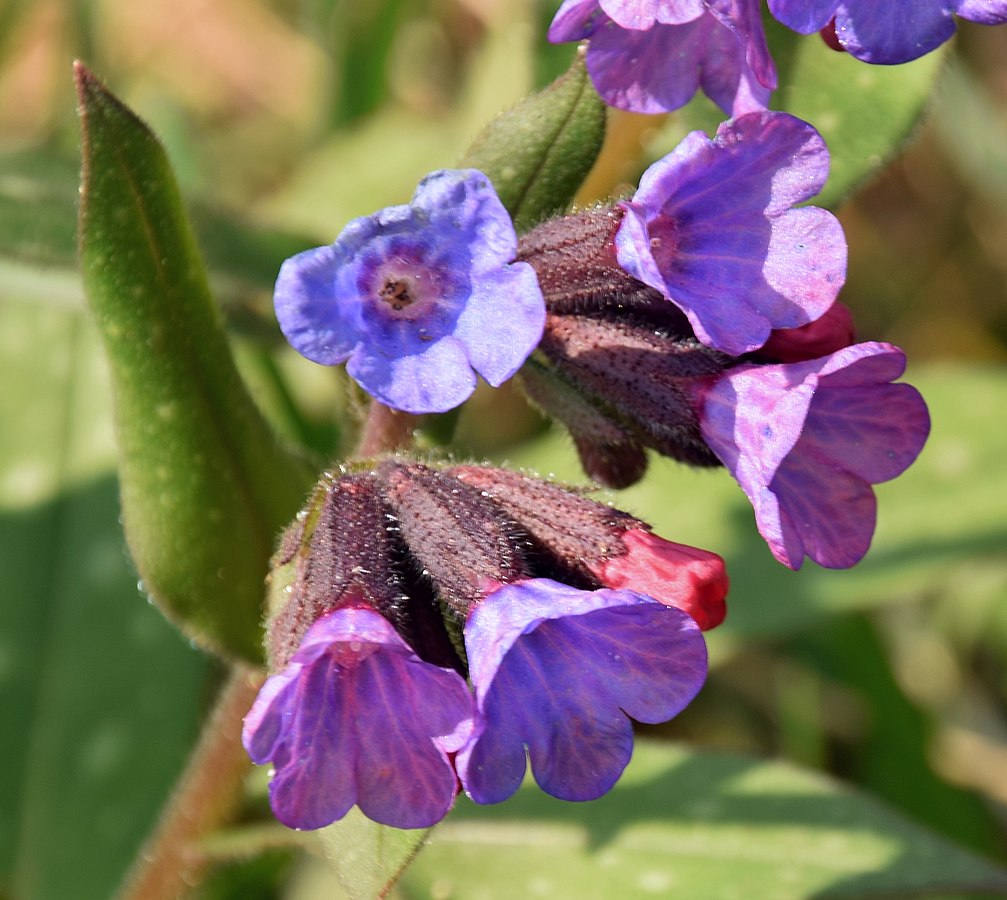- Home
- Wild Plants
- Wildflowers
- Shade plants
- Narrow-leaved lungwort
Native narrow-leaved lungwort has a very restricted distribution in Britain, in a few locations in Dorset, Hampshire and the Isle of Wight only. It has narrow, spear-shaped spotted leaves and blue-purple flowers1.. It is a very attractive plant that deserves a place in the garden.
Pulmonaria longifolia was first recorded botanically by Parkinson in 16292. . Traditional names include Adam and Eve, blue cowslip, soldier and his wife and Josephs and Maries. The names in pairs refer to the feature of flowers opening purple-red and changing to blue as they mature2,3.
This plant is visited by bumblebees and by the hairy-footed flower bee Anthophora plumipes. It is only recorded as a food plant for 8 species of beetles, aphids and micro-moths4. .
The common lungwort grown for centuries in cottage gardens is the non-native P. officinalis, which is occasionally found naturalised as a garden escape, especially near dwellings. It has broader more oval-shaped leaves than P. longifolia, and has flowers that tend to be a more distinctly pink when opening than those of P. longifolia.
Narrow-leaved Lungwort Pulmonaria longifolia
Family – Boraginaceae, Borage family
Herbaceous perennial – up to 40cm tall c20cm spread
Flowering – March to May
Soils - Neutral to alkaline
Position – Partial shade, prefers soil that is rich in humus.
.jpg)


References
1. Stace, C. 2010. New Flora of the British Isles, Third Edition. P. 554.
2. Pearman, D. (2017). The Discovery of the Native Flora of Britain and Ireland, Botanical Society of Britain & Ireland. P. 329
2. Grigson, G. 1995. An Englishman’s Flora. P. 282.
3. Vickery, R. 2019. Vickery’s Folk Flora, An A to Z of the Folklore and Uses of British and Irish Plants. P. 434.
4. See the Biological Record Centre database
Page written by Marc Carlton. Compiled by Steve Head
Common lungwort
Pulmonaria officinalis
Narrow-leaved Lungwort Pulmonaria longifolia
Herbaceous perennial – up to 40cm tall c20cm spread
Flowering – March to May
Soils - Neutral to alkaline
Position – Partial shade, prefers soil that is rich in humus.

.jpg)
Native narrow-leaved lungwort has a very restricted distribution in Britain, in a few locations in Dorset, Hampshire and the Isle of Wight only. It has narrow, spear-shaped spotted leaves and blue-purple flowers1.. It is a very attractive plant that deserves a place in the garden.
Pulmonaria longifolia was first recorded botanically by Parkinson in 16292. . Traditional names include Adam and Eve, blue cowslip, soldier and his wife and Josephs and Maries. The names in pairs refer to the feature of flowers opening purple-red and changing to blue as they mature2,3.
This plant is visited by bumblebees and by the hairy-footed flower bee Anthophora plumipes. It is only recorded as a food plant for 8 species of beetles, aphids and micro-moths4. .
The common lungwort grown for centuries in cottage gardens is the non-native P. officinalis, which is occasionally found naturalised as a garden escape, especially near dwellings. It has broader more oval-shaped leaves than P. longifolia, and has flowers that tend to be a more distinctly pink when opening than those of P. longifolia.
Common lungwort
Pulmonaria officinalis
References
1. Stace, C. 2010. New Flora of the British Isles, Third Edition. P. 554.
2. Pearman, D. (2017). The Discovery of the Native Flora of Britain and Ireland, Botanical Society of Britain & Ireland. P. 329
2. Grigson, G. 1995. An Englishman’s Flora. P. 282.
3. Vickery, R. 2019. Vickery’s Folk Flora, An A to Z of the Folklore and Uses of British and Irish Plants. P. 434.
Page written by Marc Carlton. Compiled by Steve Head







